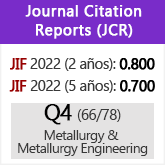Evolución microestructural de la ZAC en la unión soldada con MIG sobre una aleación de aluminio AA7020W
DOI:
https://doi.org/10.3989/revmetalm.2003.v39.i4.341Palabras clave:
Microestructura, Calorimetría diferencial de barrido, Soldadura, Microscopía electrónica de transmisiónResumen
El presente estudio evalúa los cambios acaecidos a lo largo de la zona afectada por el calor, ZAC, bajo dos ópticas diferentes pero complementarias: la microscopía electrónica de transmisión (TEM) y la calorimetría diferencial de barrido (DSC). Se han obtenido cambios claros y definidos en cuanto a la morfología y tamaño de los precipitados observados por TEM a lo largo de la ZAC, los cuales se correlacionan con los diferentes barridos de DSC. Palabras clave Aleación de aluminio.
Descargas
Los datos de descargas todavía no están disponibles.
Descargas
Publicado
2003-08-30
Cómo citar
Bloem, C. A., Salvador, M. D., Amigó, V., & Busquets, D. (2003). Evolución microestructural de la ZAC en la unión soldada con MIG sobre una aleación de aluminio AA7020W. Revista De Metalurgia, 39(4), 298–303. https://doi.org/10.3989/revmetalm.2003.v39.i4.341
Número
Sección
Nota Técnica
Licencia
Derechos de autor 2003 Consejo Superior de Investigaciones Científicas (CSIC)

Esta obra está bajo una licencia internacional Creative Commons Atribución 4.0.
© CSIC. Los originales publicados en las ediciones impresa y electrónica de esta Revista son propiedad del Consejo Superior de Investigaciones Científicas, siendo necesario citar la procedencia en cualquier reproducción parcial o total.Salvo indicación contraria, todos los contenidos de la edición electrónica se distribuyen bajo una licencia de uso y distribución “Creative Commons Reconocimiento 4.0 Internacional ” (CC BY 4.0). Puede consultar desde aquí la versión informativa y el texto legal de la licencia. Esta circunstancia ha de hacerse constar expresamente de esta forma cuando sea necesario.
No se autoriza el depósito en repositorios, páginas web personales o similares de cualquier otra versión distinta a la publicada por el editor.

















